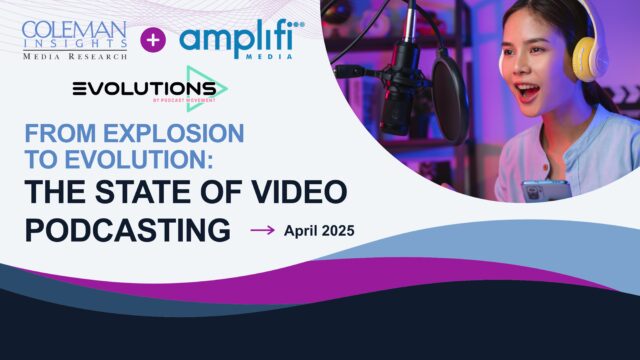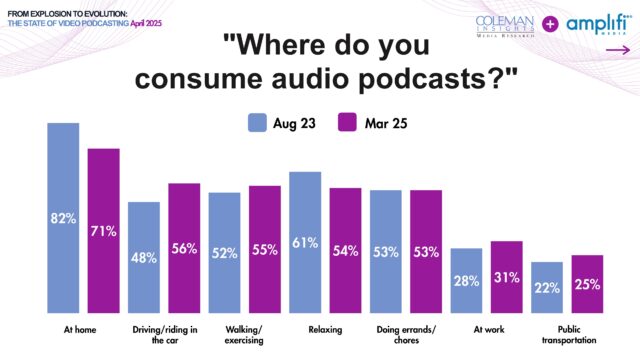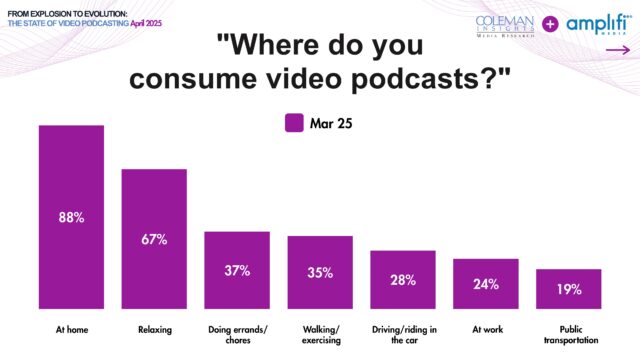Evolutions is the offshoot of the original flagship Podcast Movement conference, and I spent last week there in Chicago.
It was a weird vibe.
Early Podcast Movement conferences reminded me of old-school radio conferences – high energy mixed with electric curiosity. That’s not to say this one didn’t have energy, but it was nervous energy. It had plenty of curiosity, but anxious curiosity. Podcasting is at a crossroads thanks to the overwhelming impact of video and YouTube. Everyone in the industry knows it, and I sense a feeling of impending loss of the audio-focused medium we love.
You might not expect the guy who just presented “The State of Video Podcasting 2025” study to be the one to talk you off the ledge, but I’m going to try to do just that.

The key findings from our new study in collaboration with Amplifi Media do show a remarkable shift in podcast consumption patterns. Since our last study 18 months ago, YouTube’s share of podcast consumption increased from 60% to 70% of the total US market. While that didn’t come at the expense of other platforms, no other platform grew in any significant way, including Spotify, which has been very aggressively pushing video of late. The reach of 70% of all podcast consumers is stunning. So is the fact that 77% of podcast consumers alternate between audio and video. It is now a hybrid medium and if you want to grow your audience, most podcasters would be well served to offer their content in video form so their fans have a choice of how they want to watch or listen.
One could easily interpret the surge of video in podcasting as some sort of death knell for audio.
It. Is. Not.
In fact, one of the most important findings in our research is in the answer to the question, “Where do you consume podcasts?” Video podcasting is dominantly consumed at home, where audio used to rule. A year and a half ago, 48% of podcast consumers said they listened to audio podcasts in the car. Today, it’s 56%, surging from #5 to #2 in the list of audio consumption locations. As more consumers drive connected cars and can easily access podcast platforms, this number should grow.

In a blend of activities, “While exercising or walking” moves from 52% to 55%, up #4 to #3. Audio podcast usage is also up “while using public transportation” and at work. Where is audio usage down? At home and “While relaxing, not doing anything else.” Audio podcast consumption is becoming more active, while passive usage is becoming video’s domain.
We didn’t ask where video consumption takes place in our last study, but note the dominant top two in this study, “At home” and “Relaxing, not doing anything else”.

One isn’t taking the place of the other. They complement each other. If executed and promoted properly, you can see how audio and video in tandem can increase podcasting’s share of the overall media pie.
Podcasters should lean into where their particular content is strongest, and lean into the experiential way consumers are using it. Consider utilizing research to better understand how your particular target audience wants to consume it, so you can craft a growth strategy specific to them. The in-car number is important, but we can’t expect consumers to just find podcasts. We must aggressively and loudly train the habit.
What you should not do is hang your head and think for one second that audio is somehow being replaced by video. Intimate, one-to-one, spoken word audio is what made this medium great, continues to keep it great, and will play a crucial role in its next era, alongside video.
Amplifi Media’s Steve Goldstein and I will share findings from “The State of Video Podcasting 2025” on a live webinar on Thursday, April 17th at 2PM ET. I hope you’ll register and join us.
